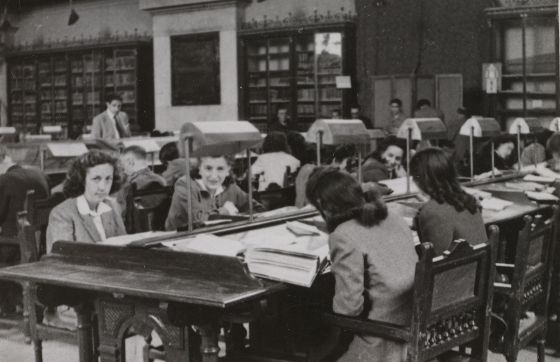WOMEN'S HISTORY
20 written lines that won Spain’s women their library cards
Antonia Gutiérrez's 1836 letter opened up the Biblioteca Nacional to all
Madrid

A group of women in the reading room of Spain's National Library. Women were forbidden from entering until 1837. CARLOS MONTES / BNE
It takes a great deal of self-confidence to sit down at a desk and ask for the moon in just 20 lines. In 1955, Rosa Parks ended racial segregation in the United States by refusing to give up her seat on an Alabama bus. A century earlier, with her 20-line letter, Antonia Gutiérrez Bueno — whose name nobody remembers today — ended a history of gender discrimination at Spain's national library, the Biblioteca Nacional (BNE) in Madrid, that went all the way back to 1713.
Antonia Gutiérrez Bueno probably thought that if she didn't stretch out her hand, she would never reach the moon. And that is precisely what the BNE was at the time: a place as inaccessible to women as the lunar surface, with the small exception of national holidays, when ladies were allowed inside for what amounted to a guided tour of the look-but-don't-touch variety.
When she sat down to write her letter to the minister of the interior, Antonia Gutiérrez (1781-1874) was 56 years old, and had published two works: volume one of a historical and biographical dictionary of famous women, and a collection of essays that she had translated from French on the subject of cholera and its treatment, including the application of leeches in the anal region. Both books provide insight into their author, especially her intellectual ambitions and her interest in public health, two things that undoubtedly must have seemed extravagant to other 19th-century women.
When she sat down to write her letter to the minister, Antonia Gutiérrez was 56 and had published two works
Antonia had lived in Paris until her husband's death, and been raised in a home filled with books and dictionaries in various languages, as well as scientific treatises and even a piano. Antonia was the third child of Mariana Ahoiz y Navarro and Pedro Gutiérrez Bueno, an enlightened man who ended up working as the king's pharmacist and taught his daughters to think beyond their domestic duties.
"Her father was a leading man of science and Antonia had access to an unconventional education," says Gema Hernández Carralón, chief of the BNE's museum and a scholar of the first female researcher to set foot in the hallowed institution. "She was a friend of [playwright and poet] Moratín, who used to call her Toinette," she adds.
Hernández Carralón suspects — although she has no way of proving her hypothesis — that Antonia Gutiérrez wrote the first volume of her biographical dictionary just as an excuse to be allowed into the BNE. The truth is, she never completed that work, which she published under the male-sounding pseudonym of Eugenio Ortazán y Brunet and dedicated to "the fairer sex," as any self-respecting gentleman would.
A room just for women would greatly increase library equipment and personnel expenses
"Finding it difficult, and even impossible, because of my circumstances, to procure the necessary books to continue my work, which is gaining significant acceptance from the public...," she wrote in her 1836 letter, before going on to request permission to use the BNE. The speed of the reply was truly surprising. Just one month later, history had been changed, perhaps in part because of the unusual circumstance that Spain was then ruled by a woman, the queen regent María Cristina, who ordered Antonia to be granted authorization to enter the BNE and conduct her research — along with any other woman who might wish to access a place that, back then, contained all the knowledge in the world.
"This half of the population still has convents in which to be locked away, but no libraries in which to be educated," said one of the queen's advisers, proposing that the "barbaric" sexist discrimination in Spain's public libraries be ended once and for all.
That was when the director of the BNE, José María Patiño, who had accepted Gutiérrez's petition without a peep, suddenly wrote an angry letter to the secretary of state for the interior listing all the problems that would be associated with granting blanket permission for all women to enter the premises. He said the room would be insufficient "if the number of women who presumed to take advantage of this benefit exceeded the number of five or six." And a room just for women would greatly increase equipment and personnel expenses. "It would be necessary to purchase tables, a brazier, writing desks and all the necessary equipment for attending ladies to be here with the corresponding decency," the director added.
Patiño asked the secretary to "incline the royal disposition of Her Majesty" toward limiting the female presence at the BNE to just Gutiérrez, or else to increase the library's budget in order to make the necessary adjustments. The regent must have not appreciated the tone of the letter, because her next communication to the BNE stated quite clearly that as many women should be allowed in as requested entry, "and in the fortunate case that their numbers should exceed five or six, do make it manifest, detailing the spending increase that is indispensable."
Records in the BNE archive do not show the exact date Gutiérrez finally walked into a library where her own work had arrived before her, and sat down in a separate room to request all the books she had always wanted to read. After that, all she published was articles, some of them defending women's education.
Gutiérrez tore down a wall: she reached the moon. Others would follow in her footsteps, including Ángela García Rivas, who became the first female librarian at the BNE a century ago. It was only in 1990 that the national library got its first female director, Alicia Girón.






















No hay comentarios:
Publicar un comentario